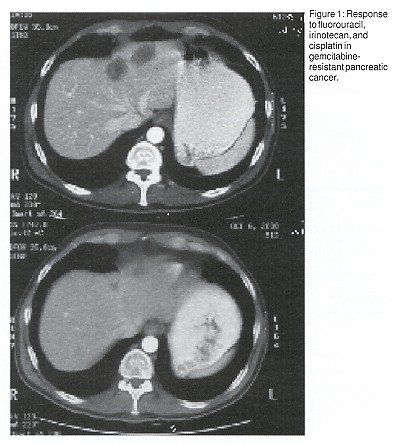Cisplatin/Irinotecan Combination Produces Responses in Gastric/Esophageal Cancers
NEW YORK-The cisplatin/irinotecan combination produces responses among patients with gastric and esophageal cancers, David H. Ilson, MD, PhD, reported at the Vanderbilt University Symposium. Dr. Ilson is assistant attending physician in the Department of Gastrointestinal Oncology, Memorial Sloan-Kettering Cancer Center, New York.
NEW YORKThe cisplatin/irinotecan combination produces responses among patients with gastric and esophageal cancers, David H. Ilson, MD, PhD, reported at the Vanderbilt University Symposium. Dr. Ilson is assistant attending physician in the Department of Gastrointestinal Oncology, Memorial Sloan-Kettering Cancer Center, New York.
Irinotecan (Camptosar) has demonstrated efficacy in gastric/esophageal cancer cell lines and in xenografts. Both cisplatin (Platinol) and irinotecan are active as single agents against gastric and esophageal cancer, Dr. Ilson noted. Cisplatin induces DNA/cisplatin adducts, and irinotecan blocks cellular repair mechanisms by inhibiting topoisomerase I. Together, cisplatin and SN-38, the active metabolite of irinotecan, have shown synergistic activity in vitro. This includes reduced removal of DNA cross links and growth inhibition with simultaneous delivery.
The cisplatin/irinotecan combination for gastric cancer has been most widely studied in Japan. As related by Dr. Ilson, Japanese phase I/II studies have shown response rates of 27% to 42%. Dose-limiting toxicities have mainly been neutropenia or diarrhea.
Minimal Toxicity
Dr. Ilson and colleagues at Memorial Sloan-Kettering Cancer Center conducted a phase I study of weekly low-dose irinotecan 65 mg/m2 plus cisplatin 30 mg/m2, 4 weeks on, 2 weeks off. "Surprisingly, toxicity was minimal in this phase I trial, and dose-limiting toxicity was neutropenia," Dr. Ilson said. "We saw responses in a number of upper GI cancers, in particular esophageal cancer, and this led to a phase II trial in 35 patients with esophageal cancer. The primary study endpoint was response rate. Secondary endpoints were dysphagia relief, quality of life, toxicity, and survival.
"The overall response rate was 57%, including two complete responses (5%), 18 partial responses (52%), with a median response duration of 4.2 months, and median actuarial survival of 14.6 months," Dr. Ilson reported.
Dysphagia relief was notable. Among the 20 patients with evaluable dysphagia at baseline, 70% had complete resolution of dysphagia, and another 20% had improvement. "So 90% of patients had significant improvement of swallowing problems with chemotherapy alone," Dr. Ilson said.
Toxicity in this phase II trial was manageable. About half of patients had grade 3/4 neutropenia; 31% had grade 3 anemia; 11% had grade 3 diarrhea; and 6% had grade 3 nausea/vomiting. Dr. Ilson said that only 17% of patients were hospitalized for complications of therapy, most commonly neutropenia or diarrhea.
Confirmatory Trial
A confirmatory community-based phase II trial of this regimen in esophageal cancer will soon be enrolling patients with metastatic or unresectable disease. The treatment regimen is cisplatin 30 mg/m2 and irinotecan 54 mg/m2, cycled 2 weeks on and 1 week off. Primary endpoints are response rate and dysphagia relief.
Investigators at M. D. Anderson Cancer Center in Houston have conducted a similar trial in 39 patients with gastric and gastroesophageal junction cancers. There were significant delays of therapy in this trial38% of doses were delayed and 23% were canceled. Granulocyte colony stimulating factor (G-CSF) was used in 59% of patients, and 36% were hospitalized for neutropenia or diarrhea. One patient died. This experience has reinforced the change to a 2-week-on, 1-week-off schedule.
In a Memorial Sloan-Kettering trial of cisplatin/irinotecan in 18 patients with gastric cancer, the partial response rate was 33%. Dr. Ilson said that 44% of patients had grade 3/4 neutropenia and 22% had grade 3 diarrhea. "This was almost a doubling of the diarrhea rate in the previous study," Dr. Ilson said.
Other initial trials have included:
tests of single-agent irinotecan at 125 mg/m2/wk in esophageal and gastric cancer
irinotecan 125 mg/m2 plus fluorouracil (5-FU) plus folinic acid in gastric and gastroesophageal junction cancer
comparison of irinotecan 200 mg/m2 plus cisplatin 60 mg/m2 q3 wks to irinotecan 80 mg/m2 plus folinic acid 500 mg/m2 plus 5-FU 2 g/m2 IV, 6 wks on, 1 off in esophageal and gastric cancer.
Dr. Ilson added that phase I trials in development at Memorial Sloan-Kettering include weekly irinotecan/cisplatin plus concurrent radiotherapy, weekly paclitaxel (Taxol), or weekly fluorouracil.
A phase I study of weekly paclitaxel or 5-FU plus irinotecan/cisplatin in patients with esophageal, gastric, or pancreatic cancers produced "responses in previously treated pancreatic and gastric cancer," Dr. Ilson stated. Figure 1 shows an example of a response to 5-FU, irinotecan, and cisplatin, in gemcitabine (Gemzar)-resistant pancreatic cancer.) "Due to reduced toxicity, most of us have accepted the 2 weeks on/1 week off schedule used in this trial as our standard approach."

There are 33,800 new cases of esophageal and gastric cancers in the United States each year, Dr. Ilson noted, and 25,100 deaths, accounting for 4% of American cancer deaths. "Mortality is 90% for esophageal cancer and 60% for gastric cancer," he said.
Newsletter
Stay up to date on recent advances in the multidisciplinary approach to cancer.
Elevating the Quality of Cancer Care via Cross-Department Collaboration
Experts from Sibley Memorial Hospital discuss how multidisciplinary work has enhanced outcomes such as survival and resource use at their institution.